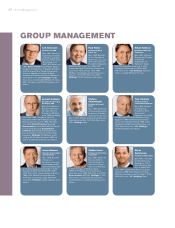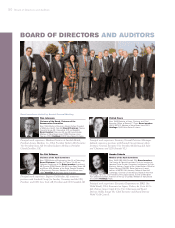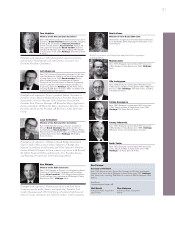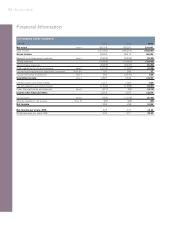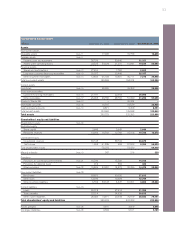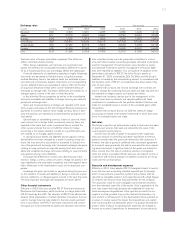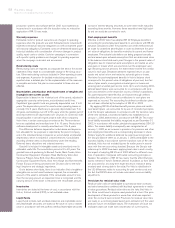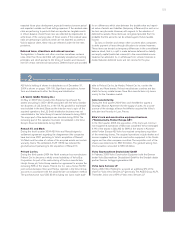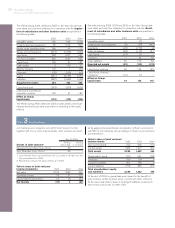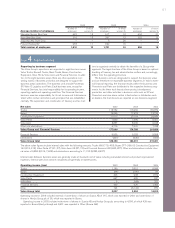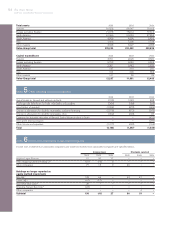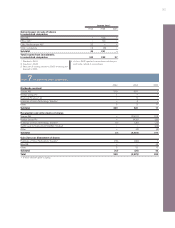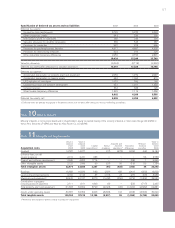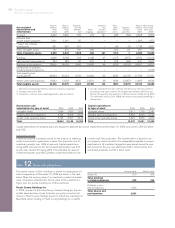Volvo 2004 Annual Report Download - page 60
Download and view the complete annual report
Please find page 60 of the 2004 Volvo annual report below. You can navigate through the pages in the report by either clicking on the pages listed below, or by using the keyword search tool below to find specific information within the annual report.
58 The Volvo Group
Notes to consolidated financial statements
production systems and software before 2001 was expensed as
incurred and in accordance with the transition rules no retroactive
application of RR 15 was made.
Warranty expenses
Estimated costs for product warranties are charged to operating
expenses when the products are sold. Estimated costs include both
expected contractual warranty obligations as well as expected good-
will warranty obligations. Estimated costs are determined based upon
historical statistics with consideration of known changes in product
quality, repair costs or similar. Costs for campaigns in connection
with specific quality problems are charged to operating expenses
when the campaign is decided and announced.
Restructuring costs
Restructuring costs are reported as a separate line item in the income
statement if they relate to a considerable change of the Group struc-
ture. Other restructuring costs are included in Other operating income
and expenses. A provision for decided restructuring measures is
reported when a detailed plan for the implementation of the measures
is complete and when this plan is communicated to those who are
affected.
Depreciation, amortization and impairments of tangible and
intangible non-current assets
Depreciation is based on the historical cost of the assets, adjusted in
appropriate cases by write-downs, and estimated useful lives.
Capitalized type-specific tools are generally depreciated over 2 to 8
years. The depreciation period for assets under operating leases is
normally 3 to 5 years. Machinery is generally depreciated over 5 to
20 years, and buildings over 25 to 50 years, while the greater part of
land improvements are depreciated over 20 years. In connection with
its participation in aircraft engine projects with other companies,
Volvo Aero in certain cases pays an entrance fee. These entrance
fees are capitalized and amortized over 5 to 10 years. Product and
software development is normally amortized over 3 to 8 years.
The difference between depreciation noted above and deprecia-
tion allowable for tax purposes is reported by the parent company
and in the individual Group companies as accumulated accelerated
depreciation, which is included in untaxed reserves. Consolidated
reporting of these items is described below under the heading
Deferred taxes, allocations and untaxed reserves.
Goodwill is included in intangible assets and amortized over its
estimated useful life. The amortization period is 5 to 20 years. The
goodwill amounts pertaining to Renault Trucks, Mack Trucks, Volvo
Construction Equipment, Champion Road Machinery, Volvo Aero
Services, Prévost, Nova BUS, Volvo Bus de Mexico, Volvo
Construction Equipment Korea, Volvo Aero Norge and Kommersiella
Fordon Europa are being amortized over 20 years due to the hold-
ings’ long-term and strategic importance.
If, at a balance sheet date, there is an indication that a tangible or
intangible non-current asset has been impaired, the recoverable
amount of the asset is estimated. If the recoverable amount is less
than the carrying amount, an impairment loss is recognized and the
carrying amount of the asset is reduced to the recoverable amount.
Inventories
Inventories are stated at the lower of cost, in accordance with the
first-in, first-out method (FIFO), or net realizable value.
Liquid funds
Liquid funds include cash and bank balances and marketable secur-
ities. Marketable securities are stated at the lower of cost or market
value in accordance with the portfolio method. Marketable securities
consist of interest-bearing securities, to some extent with maturities
exceeding three months. However, these securities have high liquid-
ity and can easily be converted to cash.
Post-employment benefits
Effective in 2003, Volvo has adopted RR 29 Employee benefits in
accounting for post-employment benefits. In accordance with RR 29,
actuarial calculations under the projected unit credit method should
be made for all defined benefit plans in order to determine the pres-
ent value of obligations for benefits vested by its current and former
employees. The actuarial calculations are being prepared annually
and are based upon actuarial assumptions that are determined close
to the balance sheet date each year. Changes in the present value of
obligations due to revised actuarial assumptions are treated as actu-
arial gains or losses which are amortized over the employees’ aver-
age remaining service period to the extent these exceed the corridor
value for each plan. Deviations between expected return on plan
assets and actual return are treated as actuarial gains or losses.
Provisions for post-employment benefits in Volvo’s balance sheet
correspond to the present value of obligations at year-end, less fair
value of plan assets, unrecognized actuarial gains or losses and
unrecognized unvested past service costs. Up to and including 2002,
defined benefit plans were accounted for in accordance with local
rules and directives in the respective country of Volvo’s subsidiaries.
For post-employment benefits that are financed through defined
contribution plans, Volvo’s annual contributions to such plans are
expensed as incurred. The accounting for defined contribution plans
has not been affected by the adoption of RR 29 in 2003.
By applying RR 29 all defined-benefit pension plans and health-
care benefit plans are accounted for by use of consistent principles,
in all the Group’s subsidiaries. In accordance with the transition rules
of the new standard, a transitional liability was established as at
January 1, 2003, determined in accordance with RR 29. This transi-
tional liability exceeded the liability recognized as per December 31,
2002, in accordance with earlier principles by approximately SEK 2.3
billion. The excess liability consequently was recognized as at
January 1, 2003, as an increase in provisions for pensions and other
post-employment benefits and a corresponding decrease in share-
holders’ equity. No additional deferred tax asset was recognized in
the Group’s balance sheet as at January 1, 2003, attributable to the
transition liability. In accordance with the transition rules of the new
standard, Volvo has not restated figures for earlier years in accord-
ance with the new accounting standard. Because the Group’s sub-
sidiaries up to 2002 have been applying local rules in each country,
the impact of adopting RR 29 as of 2003 differs for different coun-
tries of operations. Compared with earlier accounting principles in
Sweden, the adoption of RR 29 has mainly had the effect that plan
assets invested in Volvo’s Swedish pension foundation as from 2003
are accounted for at a long-term expected return instead of being
revalued each closing date to fair value. For Volvo’s subsidiaries in
the US, differences relate to accounting for past service costs and
the fact that RR 29 does not include rules about minimum liability
adjustments.
Provisions for residual value risks
Residual value risks are attributable to operational lease contracts
and sales transactions combined with buy-back agreements or residu-
al value guarantees. Residual value risks are the risks that Volvo in
the future would have to dispose used products at a loss if the price
development of these products is worse than what was expected
when the contracts were entered. Provisions for residual value risks
are made on a continuing basis based upon estimations of the used
products’ future net realizable values. The estimations of future net
realizable values are made with consideration of current prices,


